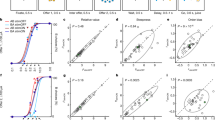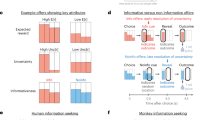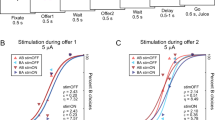Abstract
The orbitofrontal cortex plays a central role in good-based economic decisions. When subjects make choices, neurons in this region represent the identities and values of offered and chosen goods. Notably, choices in different behavioral contexts may involve a potentially infinite variety of goods. Thus a fundamental question concerns the stability versus flexibility of the decision circuit. Here we show in rhesus monkeys that neurons encoding the identity or the subjective value of particular goods in a given context 'remap' and become associated with different goods when the context changes. At the same time, the overall organization of the decision circuit and the function of individual cells remain stable across contexts. In particular, two neurons supporting the same decision in one context also support the same decision in different contexts. These results demonstrate how the same neural circuit can underlie economic decisions involving a large variety of goods.
This is a preview of subscription content, access via your institution
Access options
Subscribe to this journal
Receive 12 print issues and online access
$209.00 per year
only $17.42 per issue
Buy this article
- Purchase on Springer Link
- Instant access to full article PDF
Prices may be subject to local taxes which are calculated during checkout






Similar content being viewed by others
References
Rahman, S., J Sahakia, B., N Cardinal, R., Rogers, R. & Robbins, T. Decision making and neuropsychiatry. Trends Cogn. Sci. 5, 271–277 (2001).
Volkow, N.D. & Li, T.K. Drug addiction: the neurobiology of behaviour gone awry. Nat. Rev. Neurosci. 5, 963–970 (2004).
Strauss, G.P., Waltz, J.A. & Gold, J.M. A review of reward processing and motivational impairment in schizophrenia. Schizophr. Bull. 40 (suppl. 2), S107–S116 (2014).
Gallagher, M., McMahan, R.W. & Schoenbaum, G. Orbitofrontal cortex and representation of incentive value in associative learning. J. Neurosci. 19, 6610–6614 (1999).
Camille, N., Griffiths, C.A., Vo, K., Fellows, L.K. & Kable, J.W. Ventromedial frontal lobe damage disrupts value maximization in humans. J. Neurosci. 31, 7527–7532 (2011).
Rudebeck, P.H., Saunders, R.C., Prescott, A.T., Chau, L.S. & Murray, E.A. Prefrontal mechanisms of behavioral flexibility, emotion regulation and value updating. Nat. Neurosci. 16, 1140–1145 (2013).
Thorpe, S.J., Rolls, E.T. & Maddison, S. The orbitofrontal cortex: neuronal activity in the behaving monkey. Exp. Brain Res. 49, 93–115 (1983).
Padoa-Schioppa, C. & Assad, J.A. Neurons in the orbitofrontal cortex encode economic value. Nature 441, 223–226 (2006).
Raghuraman, A.P. & Padoa-Schioppa, C. Integration of multiple determinants in the neuronal computation of economic values. J. Neurosci. 34, 11583–11603 (2014).
Howard, J.D., Gottfried, J.A., Tobler, P.N. & Kahnt, T. Identity-specific coding of future rewards in the human orbitofrontal cortex. Proc. Natl. Acad. Sci. USA 112, 5195–5200 (2015).
Zhou, J., Jia, C., Feng, Q., Bao, J. & Luo, M. Prospective coding of dorsal raphe reward signals by the orbitofrontal cortex. J. Neurosci. 35, 2717–2730 (2015).
Klein-Flügge, M.C., Barron, H.C., Brodersen, K.H., Dolan, R.J. & Behrens, T.E. Segregated encoding of reward-identity and stimulus-reward associations in human orbitofrontal cortex. J. Neurosci. 33, 3202–3211 (2013).
Lara, A.H., Kennerley, S.W. & Wallis, J.D. Encoding of gustatory working memory by orbitofrontal neurons. J. Neurosci. 29, 765–774 (2009).
McDannald, M.A. et al. Orbitofrontal neurons acquire responses to 'valueless' Pavlovian cues during unblocking. eLife 3, e02653 (2014).
Critchley, H.D. & Rolls, E.T. Hunger and satiety modify the responses of olfactory and visual neurons in the primate orbitofrontal cortex. J. Neurophysiol. 75, 1673–1686 (1996).
Gottfried, J.A., O'Doherty, J. & Dolan, R.J. Encoding predictive reward value in human amygdala and orbitofrontal cortex. Science 301, 1104–1107 (2003).
Sul, J.H., Kim, H., Huh, N., Lee, D. & Jung, M.W. Distinct roles of rodent orbitofrontal and medial prefrontal cortex in decision making. Neuron 66, 449–460 (2010).
Padoa-Schioppa, C. Neurobiology of economic choice: a good-based model. Annu. Rev. Neurosci. 34, 333–359 (2011).
Rustichini, A. & Padoa-Schioppa, C. A neuro-computational model of economic decisions. J. Neurophysiol. 114, 1382–1398 (2015).
Padoa-Schioppa, C. Neuronal origins of choice variability in economic decisions. Neuron 80, 1322–1336 (2013).
Agresti, A. An Introduction to Categorical Data Analysis (Wiley, 2007).
Gottfried, J.A. & Zelano, C. The value of identity: olfactory notes on orbitofrontal cortex function. Ann. NY Acad. Sci. 1239, 138–148 (2011).
Pritchard, T.C. et al. Satiety-responsive neurons in the medial orbitofrontal cortex of the macaque. Behav. Neurosci. 122, 174–182 (2008).
Rolls, E.T. The orbitofrontal cortex and reward. Cereb. Cortex 10, 284–294 (2000).
Small, D.M. Flavor is in the brain. Physiol. Behav. 107, 540–552 (2012).
Verhagen, J.V. & Engelen, L. The neurocognitive bases of human multimodal food perception: sensory integration. Neurosci. Biobehav. Rev. 30, 613–650 (2006).
Cisek, P. Making decisions through a distributed consensus. Curr. Opin. Neurobiol. 22, 927–936 (2012).
Glimcher, P.W. Foundations of Neuroeconomic Analysis (Oxford University Press, 2011).
Rangel, A. & Hare, T. Neural computations associated with goal-directed choice. Curr. Opin. Neurobiol. 20, 262–270 (2010).
Rushworth, M.F., Kolling, N., Sallet, J. & Mars, R.B. Valuation and decision-making in frontal cortex: one or many serial or parallel systems? Curr. Opin. Neurobiol. 22, 946–955 (2012).
Wang, X.J. Probabilistic decision making by slow reverberation in cortical circuits. Neuron 36, 955–968 (2002).
Muller, R.U. & Kubie, J.L. The effects of changes in the environment on the spatial firing of hippocampal complex-spike cells. J. Neurosci. 7, 1951–1968 (1987).
Wills, T.J., Lever, C., Cacucci, F., Burgess, N. & O'Keefe, J. Attractor dynamics in the hippocampal representation of the local environment. Science 308, 873–876 (2005).
Padoa-Schioppa, C. Range-adapting representation of economic value in the orbitofrontal cortex. J. Neurosci. 29, 14004–14014 (2009).
Kobayashi, S., Pinto de Carvalho, O. & Schultz, W. Adaptation of reward sensitivity in orbitofrontal neurons. J. Neurosci. 30, 534–544 (2010).
Padoa-Schioppa, C. & Rustichini, A. Rational attention and adaptive coding: a puzzle and a solution. Am. Econ. Rev. 104, 507–513 (2014).
Tremblay, L. & Schultz, W. Relative reward preference in primate orbitofrontal cortex. Nature 398, 704–708 (1999).
Schultz, W. Neuronal reward and decision signals: from theories to data. Physiol. Rev. 95, 853–951 (2015).
Morrison, S.E., Saez, A., Lau, B. & Salzman, C.D. Different time courses for learning-related changes in amygdala and orbitofrontal cortex. Neuron 71, 1127–1140 (2011).
Padoa-Schioppa, C. & Assad, J.A. The representation of economic value in the orbitofrontal cortex is invariant for changes of menu. Nat. Neurosci. 11, 95–102 (2008).
Cai, X. & Padoa-Schioppa, C. Contributions of orbitofrontal and lateral prefrontal cortices to economic choice and the good-to-action transformation. Neuron 81, 1140–1151 (2014).
Saez, A., Rigotti, M., Ostojic, S., Fusi, S. & Salzman, C.D. Abstract context representations in primate amygdala and prefrontal cortex. Neuron 87, 869–881 (2015).
Neter, J., Wasserman, W. & Kutner, M.H. Applied Linear Statistical Models: Regression, Analysis of Variance, and Experimental Designs (Irwin, Homewood, Illinois, USA, 1990).
Acknowledgements
We thank H. Schoknecht for help with animal training, A. Raghuraman for help with recording and X. Cai, K. Conen, E. Han, I. Monosov and L. Snyder for comments on the manuscript. This work was supported by the National Institutes of Health (grant numbers R01-DA032758 and R01-MH104494 to C.P.-S.) and by the McDonnell Center for Systems Neuroscience (predoctoral fellowship to J.X.).
Author information
Authors and Affiliations
Contributions
J.X. and C.P.-S. designed the study; J.X. collected and analyzed the data; J.X. and C.P.-S. wrote the manuscript.
Corresponding author
Ethics declarations
Competing interests
The authors declare no competing financial interests.
Integrated supplementary information
Supplementary Figure 1 Correlation between task-related activity across trial blocks.
In this analysis, we examined whether individual neurons typically met the ANOVA criterion in the same time windows in both trial blocks. For each neuron in each block, we obtained a vector of binary variables indicating whether the cell passed the criterion in different time windows. We then calculated the correlation coefficient between the two vectors obtained for the two trial blocks. Finally, we examined the distribution of correlation coefficients across the population, separately for experimental and control cells. Correlation coefficients were typically positive, indicating that neurons were generally task-related in the same time windows. This result held true both in the experimental condition (median = 0.45) and in the control condition (median = 0.49). Moreover, the distributions obtained in the two conditions did not differ significantly from one another (p = 0.83, Kolmogorov-Smirnov test).
Supplementary Figure 2 Analysis based on neuronal responses.
The analyses presented in Fig. 3 were based on a classification involving multiple time windows (see Online Methods). For a control, we repeated the analysis comparing the classifications obtained for neuronal responses (as opposed to neurons) across trial blocks. As a reminder, a neuronal response was defined as the activity of one cell, in one time window, in one trial block, as a function of the trial type. In this analysis, we compared the two responses obtained from the same cell, in the same time window, for the two trial blocks. (Thus each cell might contribute more than one response to the figure.) (a,b,c) Control sessions (N = 553 responses). (d,e,f) Experimental sessions (N = 1,171 responses). Data are presented in the same format used for Fig. 3. Panels illustrate the response counts (a, d), the analysis of odds ratios (b, e) and the results of the bootstrap analysis (c, f). All statistical criteria are as in Fig. 3. For odds ratios, exact p values are shown in Supplementary Figs. 6e (relative to panel b) and 6f (relative to panel e). The results obtained in this analysis confirmed those obtained for neurons (Fig. 3). In other words, response counts were significantly above chance level for all positions on the main diagonal, and this results held true both in the control condition and in the experimental condition.
Supplementary Figure 3 Analysis of response similarity across trial blocks based on the R2.
We conducted a control analysis to examine whether the R2 obtained for one response in one block predicted the R2 obtained for the corresponding response in the other block. In essence, this approach avoided the classification procedure. The analysis included all pairs of responses that met the ANOVA criterion in both blocks. We first examined experimental cells. For each block, we obtained four R2 from the linear regressions on each of the 4 variables. We identified the variable providing the highest R2 in one block, and we considered the "corresponding" variable in the other block. For variables offer value A and offer value B, the corresponding variables were offer value C and offer value D, respectively. Independently of the value measured for the R2 in the A:B block, we predicted that the R2 measured for the corresponding variable in the C:D block would be typically higher than that measured for the other, non-corresponding variables (and vice versa). This is indeed what we observed. (a) Neuronal population recorded in experimental sessions (A:B, C:D). The x-axis and y-axis in the scatter plot represent the R2 obtained in the second block for the corresponding variable and other variables, respectively. While data are quite scattered, the population as a whole lies below the identity line, indicating that the variable encoded in one block is predictive of the variable encoded in the other block. Each response provided 3 data points to this plot, one for each of the "other" variables. Furthermore, we repeated the analysis using for reference the second block, and we pooled the results obtained with the two procedures. (b) For each data point in panel a we computed the difference in R2 obtained for the corresponding and other variables. The distribution obtained for the population was significantly shifted towards positive values (median = 0.24, p<10-10, Wilcoxon signed rank test). (c,d) Same analysis as in panels ab performed for the population recorded in control sessions (A:B, A:B). In panel d, the distribution of ΔR2 obtained for the population was significantly shifted towards positive values (median = 0.32, p<10-10, Wilcoxon signed rank test). (e,f,g,h) Analysis restricted to offer value responses. The four panels illustrate the results obtained when the analysis was restricted to neuronal responses classified as offer value in the reference block. The results were very similar to those obtained for the entire population. The distribution of ΔR2 was significantly shifted towards positive values for both experimental (median = 0.15, p<10-10, Wilcoxon signed rank test) and control sessions (median = 0.24, p<10-10, Wilcoxon signed rank test).
Supplementary Figure 4 Analysis of individual animals (experimental cells).
(a,b,c) Monkey V (N = 353 task-related cells). (d,e,f) Monkey C (N = 151 task-related cells). Data are presented in the same format used for Fig. 3. Panels illustrate the cell counts (a, d), the analysis of odds ratios (b, e) and the results of the bootstrap analysis (c, f). All statistical criteria are as in Fig. 3. For odds ratios, exact p values are shown in Supplementary Figs. 6g (relative to panel b) and 6h (relative to panel e). For monkey V, odds ratios were significantly above chance for all locations on the main diagonal. For monkey C, odds ratios on the main diagonal were all above chance, but the effects reached significance level only for chosen value+ cells and chosen juice cells (lower statistical power). Notably, cells classified as offer value or chosen juice in one block were not more likely to be classified as untuned in the other block, for either monkey.
Supplementary Figure 5 Analysis of conditional odds ratios.
In the analysis illustrated in Fig. 5e and based on the Breslow-Day statistics, two association strengths, namely [offer value, untuned] and [untuned, chosen juice], approached significance level. We thus conducted an additional analysis on these two associations. Specifically, we computed the conditional odds ratios for fixed levels of one dimension (Agresti, An Introduction to Categorical Data Analysis, 2007). (a) Association [offer value, untuned]. Numbers in the table indicate cell counts. Only neurons classified as offer value in the first trial block enter this table. The two columns indicate the results of the classification obtained in the second block (untuned or any of the three other classes). For this 2x2 table, odds ratio = 0.51 (p = 0.13, Fisher's exact test). In other words, the strength of the association [offer value, untuned] did not differ between conditions. Conditioning cell counts on the classification obtained in the second block provided similar results (odds ratio = 0.48; p = 0.09, Fisher's exact test). (b) Association [untuned, chosen juice]. Same format as in panel a. Only neurons classified as untuned in the first trial block enter this table. For this table, odds ratio = 0.38 (p = 0.10, Fisher's exact test). In other words, the strength of the association [untuned, chosen juice] did not differ between conditions. Conditioning cell counts on the classification obtained in the second block provided similar results (odds ratio = 0.37; p = 0.09, Fisher's exact test). In conclusion, the association strengths measured in the experimental condition were statistically indistinguishable from those measured in the control condition.
Supplementary Figure 6 Exact P values for odds ratios.
The figure shows the p values obtained using Fisher's exact test (two tails) on odds ratios throughout the paper. The correspondence between the panels of this figures and those of other figures is as follows: (a) Fig. 3b. (b) Fig. 3e. (c) Fig. 5b. (d) Fig. 5d. (e) Supplementary Fig. 2b. (f) Supplementary Fig. 2e. (g) Supplementary Fig. 4b. (h) Supplementary Fig. 4e. In each panel, red/cyan asterisks indicate that the cell counts were significantly above/below chance level (p<0.01).
Supplementary Figure 7 Chi-square values.
The table indicates the chi2 values obtained for each of the Breslow-Day tests performed for Fig. 5e.
Supplementary information
Supplementary Text and Figures
Supplementary Figures 1–7 (PDF 1052 kb)
Supplementary Methods Checklist
(PDF 454 kb)
Rights and permissions
About this article
Cite this article
Xie, J., Padoa-Schioppa, C. Neuronal remapping and circuit persistence in economic decisions. Nat Neurosci 19, 855–861 (2016). https://doi.org/10.1038/nn.4300
Received:
Accepted:
Published:
Issue Date:
DOI: https://doi.org/10.1038/nn.4300
This article is cited by
-
Value and choice as separable and stable representations in orbitofrontal cortex
Nature Communications (2020)
-
Frontal cortex neuron types categorically encode single decision variables
Nature (2019)
-
Neuronal evidence for good-based economic decisions under variable action costs
Nature Communications (2019)
-
A neuronal population code for resemblance between drug and nondrug reward outcomes in the orbitofrontal cortex
Brain Structure and Function (2019)
-
Reactivation of associative structure specific outcome responses during prospective evaluation in reward-based choices
Nature Communications (2017)



